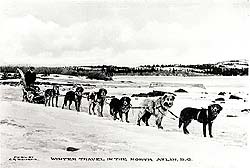 |

 
|
 |
DOG FOOD
Depending on the availability of food, the dogs were usually fed once a day, in the afternoon or, preferably, in the evening, since dogs have a tendency to become lazy after eating. The dogs were often fed dried or cooked salmon in the Yukon. "Fresh salmon is always cooked because the dogs are said to get very sick if it is fed to them raw."49 In June 1896, Inspector Constantine recommended that dried salmon be fed to the dogs at a rate of 2 pounds [1 kilo] per dog, per day. They might also be fed tallow50 or lard substitutes, which could be cooked with cornmeal.51 In 1897, a musher could buy 1 pound [450 grams] of salmon for 40 cents.52 The dogs were also fed cooked rice, cornmeal and oatmeal with bacon.53 Pemmican (dried lean bison meat pounded to a paste with melted fat) was a staple for the dogs – and for voyageurs – because it would keep for long periods of time under almost any conditions.54
 |

Winter Travel in the North;
Atlin, British Columbia, ca. 1909
Photo: C.R. Bourne
© Public domain
National Library and National Archives
of Canada, PA-032423
On August 8, 1898, gold was discovered at Atlin. The news spread like wildfire. Of the 2,000 men employed in the construction of the railway, only 700 remained on the job; the rest joined the search for gold. Atlin's first post office opened on May 1, 1899. |
On September 27, 1897, the NWMP Commissioner in Regina wrote to the Minister of the Interior, detailing what he had sent to Yukon: "In addition to regular rations I have sent in 1500 lbs [680 kilos] of pemmican . . . intended solely for running the mails & c., and each mail will carry 175 lbs [80 kilos] to be used in dire necessity, at any rate during the early portion of the winter. This amount will feed 21 dogs and 4 men for 7 days, which I calculate will be the strength of the mail party."55 In 1897, pemmican cost 35 cents per pound [450 grams].56 As a result of a major food shortage in the Yukon in 1898, other options were introduced: "dog feed had been a puzzling problem but by buying up horse meat at 5 cents to 25 cents per lb. and a fortunate purchase of ten tons of fish at Selkirk I hope we shall be able to get along allright."57

|
 |